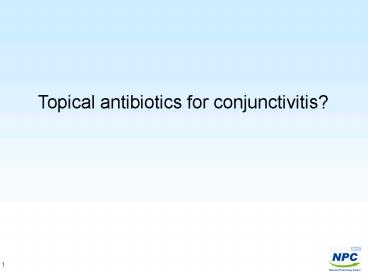Unstable angina - PowerPoint PPT Presentation
1 / 7
Title:
Unstable angina
Description:
Chloramphenicol eye drops vs. placebo. Rose PW, et al. Lancet 2005; 366: 37 43 ... with 86% of children with chloramphenicol (not statistically significant) ... – PowerPoint PPT presentation
Number of Views:83
Avg rating:3.0/5.0
Title: Unstable angina
1
Topical antibiotics for conjunctivitis?
2
Infective conjunctivitis
- It is a common condition in the community
- The differential diagnosis is very important
- How do we manage conjunctivitis?
- Ought we to prescribe antibiotics
- routinely
- using a delayed prescription
- not at all
- or selectively?
3
Background informationClinical Knowledge
Summaries (formerly PRODIGY)
- 25 of GP consultations concern the eye
infective conjunctivitis accounts for around 35
of these. - 1 in 8 children get conjunctivitis each year.
(Rose, Lancet 2005) - 3 million prescriptions for topical eye
antibiotics are supplied each year. (PPD) - BUT around 50 of cases of acute
conjunctivitis are bacterial and 50 are viral.
4
Red flags for conjunctivitis- acute glaucoma,
keratitis and uveitisClinical Knowledge Summaries
- Moderate to severe eye pain
- if there is moderate to severe pain, a secondary
cause for the conjunctivitis must be excluded. - Marked redness of the eye
- the greater the redness, the more likely it is
that there is a serious secondary cause - ciliary injection, which is not always obvious,
occurs with inflammation of deeper structures due
to a secondary cause. It is indicated by redness
and dilated blood vessels seen between the white
of the eye and the coloured part of the eye. - Reduced visual acuity
- any loss of visual acuity, measured with a
Snellen chart, may indicate a serious secondary
cause of conjunctivitis.
5
Evidence for topical antibiotics
- Most people (65) receiving placebo experienced
clinical remission after 25 days. Cochrane - 326 children aged 6 months to 12 years
- 12 general medical practices in the UK
- Chloramphenicol eye drops vs. placebo
- Rose PW, et al. Lancet 2005 366 3743
- Clinical cure at day 7, occurred in 83 of
children with placebo compared with 86 of
children with chloramphenicol (not statistically
significant)
6
What do patients think?Everitt, Kumar Little.
BJGP 2003 53 3641
- Patients
- attended as they were not aware of the
self-limiting nature of the condition - When they did know
- they preferred not to receive medication
- and were open to alternative management
approaches.
7
So what should we do?Clinical Knowledge Summaries
- Different approaches to treatment have been
suggested - treating all cases
- offering a delayed prescribing strategy
- or selectively treating cases that are most
likely to have a bacterial cause. - The most suitable method depends on individual
clinical circumstances and should be done with
the knowledge and consent of the patient (i.e.
shared decision making). - Ideas, concerns, expectations
- Options, implications, choice, justification































